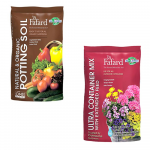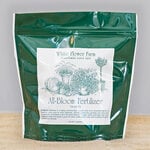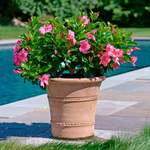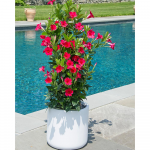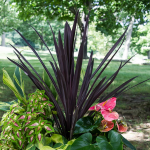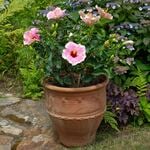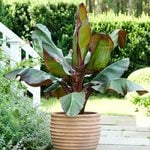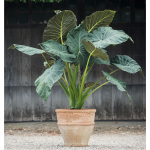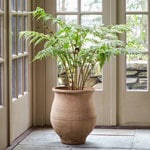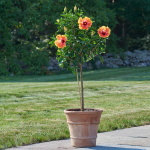Product Details
Why stoop to enjoy the vanilla scent of Heliotrope when you can have it elevated to within easy reach of your nose? The deep purple flowers keep coming all summer. The topiary stands about 4′ tall and is shipped in a 10" nursery pot.
For more information on growing Heliotrope, click on Growing Guide.
Shipping
HOW PLANTS ARE SHIPPED
The size of the plants we ship has been selected to reduce the shock of transplanting. For some, this means a large, bareroot crown. Others cannot travel bareroot or transplant best if grown in containers. We ship these perennials and annuals in 1 pint pots, except as noted. We must point out that many perennials will not bloom the first year after planting, but will the following year, amply rewarding your patience. We ship bulbs as dormant, bare bulbs, sometimes with some wood shavings or moss. Shrubs, Roses, vines, and other woody plants may be shipped bareroot or in pots. The size of the pot is noted in the quick facts for each item.
WHEN WE SHIP
We ship our bulbs and plants at the right time for planting in your area, except as noted, with orders dispatched on a first-come, first-served basis by climate zone. We also ship a wide range of containers and planters, tools, supplies, fertilizers, garden wear, garden decor items, as well as indoor decorations like wreaths and dried bouquets when available. Estimated dates for shipping are indicated in the green Shipping Details box for each item. Please supply a street address for delivery. Kindly contact us with two weeks notice, if you'll be away at the expected time of delivery.
OUR GUARANTEE
We guarantee to ship plants that are in prime condition for growing. If your order is damaged or fails to meet your expectations, we will cheerfully replace or refund it. Please contact our Customer Service Department at 1-800-503-9624 or email us at [email protected]. Please include your order number or customer number when contacting us.
Reviews
Growing guide
Latin Name Pronunciation: hee-lee-oh-tro'pee-um
Grow in full sun (afternoon shade is recommended in Zone 10 and the warmest parts of Zone 9 in the West) and evenly moist soil. Plants in dry soil are susceptible to powdery mildew, an aptly named fungal disease. Remove flower clusters as they turn brown to encourage the formation of new ones. Hardy to Zone 9 (20°F). In cold-winter climates, bring plants indoors before frost and place them in an east or west-facing window in a cool room. Water just enough to keep plants from drying out completely. Set back outdoors after the danger of frost has passed in spring.
Growing Standards:
A standard is a woody plant trained to a long, single stem. The stem is crowned with a round head of foliage and flowers. This arrangement is beautiful but also unnatural, requiring a bit of effort on the part of the gardener to prevent gravity and the unrepressed inclinations of the plant from undoing the horticulturist's handiwork.
Staking a Standard: To keep your standard standing, put it out of reach of strong winds and support it with a stake that has a diameter at least as large as the stem's and long enough that when plunged into the pot or the ground it just reaches inside the head. Fasten the standard to the stake at several points with garden twine or green plastic tie tape looped in a figure-eight around stem and stake. Check the ties periodically during the growing season and loosen them if they constrict the outward growth of the stem.
Pruning, fertilizing, and repotting: Maintain the shape of the head with selective pinching of the new shoots (overzealous pinching will prevent the formation of flower buds). Pinch each shoot between thumb and forefinger or cut with pruning shears. Do not shear the plant as though it were a hedge. Fertilize standards grown in pots as you would other pot-grown plants. If you find that a standard in a container dries out quickly after watering, the plant probably needs a larger pot. Lift it from its current pot, make four deep vertical cuts in the root ball, and place it in a new pot that is 2in wider and taller than the old one, filling in around the root ball with fresh potting mix. Water thoroughly after repotting.
Overwintering a standard: Most standards require special care to overwinter. In cold winter climates, bring standards of Abutilon, Anisodontea, Fuchsia, Heliotrope, Lantana, and Rosemary indoors before frost and place them in an east- or west-facing window in a cool room. Water just enough to keep plants from drying out completely, and do not fertilize while plants are in this not-quite-dormant period. Set back outdoors in spring when nighttime temperatures remain consistently above 55°F.
Rosemaries will survive the winter in the ground in Zones 7 and warmer. In colder zones, bring your potted Rosemary indoors in the fall. Cut your Rosemary back by about one-third before bringing it indoors to overwinter. Do not repot it often as this causes shock. Place the plant in a spot that receives a lot of sun but that stays under 60°F. A cool, sunny enclosed porch is ideal. Keep the plant away from heat sources and on the dry side. Do not fertilize.
For information on planting and care of annuals, click here.

 (2 Reviews)
(2 Reviews)

